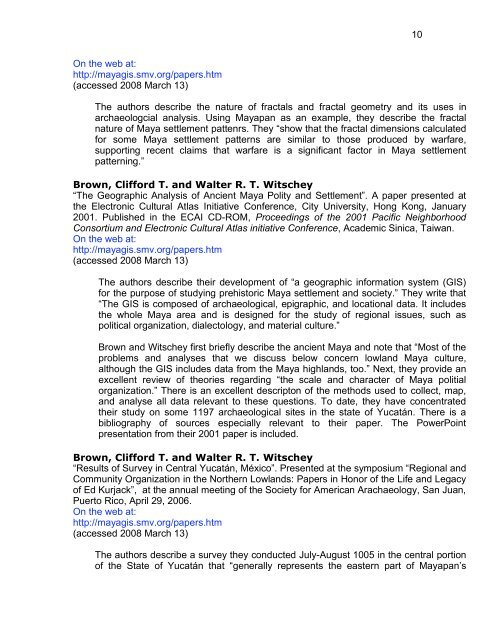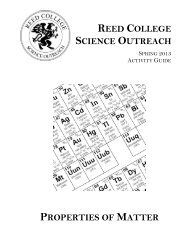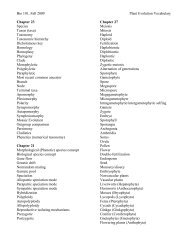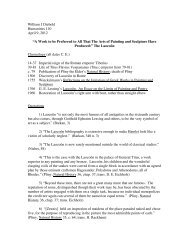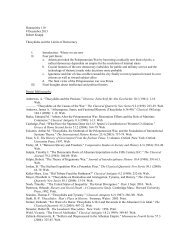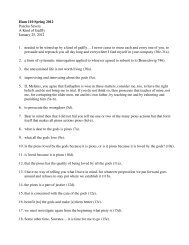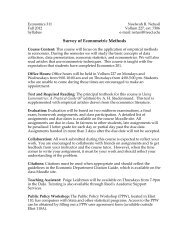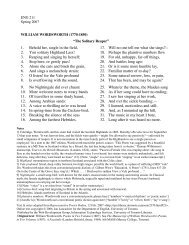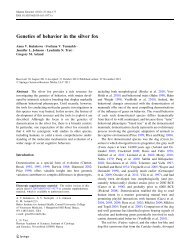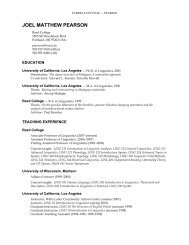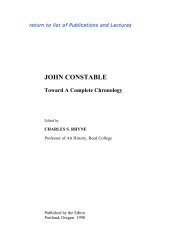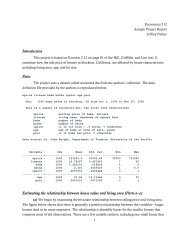Graphic and Photographic Documentation - Reed College
Graphic and Photographic Documentation - Reed College
Graphic and Photographic Documentation - Reed College
Create successful ePaper yourself
Turn your PDF publications into a flip-book with our unique Google optimized e-Paper software.
On the web at:<br />
http://mayagis.smv.org/papers.htm<br />
(accessed 2008 March 13)<br />
The authors describe the nature of fractals <strong>and</strong> fractal geometry <strong>and</strong> its uses in<br />
archaeologcial analysis. Using Mayapan as an example, they describe the fractal<br />
nature of Maya settlement pattenrs. They “show that the fractal dimensions calculated<br />
for some Maya settlement patterns are similar to those produced by warfare,<br />
supporting recent claims that warfare is a significant factor in Maya settlement<br />
patterning.”<br />
Brown, Clifford T. <strong>and</strong> Walter R. T. Witschey<br />
“The Geographic Analysis of Ancient Maya Polity <strong>and</strong> Settlement”. A paper presented at<br />
the Electronic Cultural Atlas Initiative Conference, City University, Hong Kong, January<br />
2001. Published in the ECAI CD-ROM, Proceedings of the 2001 Pacific Neighborhood<br />
Consortium <strong>and</strong> Electronic Cultural Atlas initiative Conference, Academic Sinica, Taiwan.<br />
On the web at:<br />
http://mayagis.smv.org/papers.htm<br />
(accessed 2008 March 13)<br />
The authors describe their development of “a geographic information system (GIS)<br />
for the purpose of studying prehistoric Maya settlement <strong>and</strong> society.” They write that<br />
“The GIS is composed of archaeological, epigraphic, <strong>and</strong> locational data. It includes<br />
the whole Maya area <strong>and</strong> is designed for the study of regional issues, such as<br />
political organization, dialectology, <strong>and</strong> material culture.”<br />
Brown <strong>and</strong> Witschey first briefly describe the ancient Maya <strong>and</strong> note that “Most of the<br />
problems <strong>and</strong> analyses that we discuss below concern lowl<strong>and</strong> Maya culture,<br />
although the GIS includes data from the Maya highl<strong>and</strong>s, too.” Next, they provide an<br />
excellent review of theories regarding “the scale <strong>and</strong> character of Maya politial<br />
organization.” There is an excellent descripton of the methods used to collect, map,<br />
<strong>and</strong> analyse all data relevant to these questions. To date, they have concentrated<br />
their study on some 1197 archaeological sites in the state of Yucatán. There is a<br />
bibliography of sources especially relevant to their paper. The PowerPoint<br />
presentation from their 2001 paper is included.<br />
Brown, Clifford T. <strong>and</strong> Walter R. T. Witschey<br />
“Results of Survey in Central Yucatán, México”. Presented at the symposium “Regional <strong>and</strong><br />
Community Organization in the Northern Lowl<strong>and</strong>s: Papers in Honor of the Life <strong>and</strong> Legacy<br />
of Ed Kurjack”, at the annual meeting of the Society for American Arachaeology, San Juan,<br />
Puerto Rico, April 29, 2006.<br />
On the web at:<br />
http://mayagis.smv.org/papers.htm<br />
(accessed 2008 March 13)<br />
The authors describe a survey they conducted July-August 1005 in the central portion<br />
of the State of Yucatán that “generally represents the eastern part of Mayapan’s<br />
10


